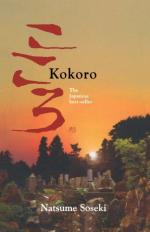
|
| Name: _________________________ | Period: ___________________ |
This test consists of 15 multiple choice questions and 5 short answer questions.
Multiple Choice Questions
1. When the narrator first sees Sensei at a teahouse by the beach, he says that two days previously he had gone where?
(a) Kagoshima.
(b) Nikko.
(c) Ichigaya.
(d) Yuigahama.
2. How many tea houses does the narrator describe on the beach in the beginning of Part I: Sensei and I?
(a) 8.
(b) 5.
(c) 2.
(d) 15.
3. When does the narrator tell Sensei and his wife he will be back in Tokyo after he graduates in Part I: Sensei and I?
(a) September.
(b) December.
(c) May.
(d) June.
4. What word from the narrative in Part I: Sensei and I, means requiring or characterized by excessive care or delicacy; painstaking?
(a) Disillusionment.
(b) Coquetry.
(c) Fastidious.
(d) Dogmatic.
5. Sensei tells the narrator that his Western friend is something of what in Part I: Sensei and I?
(a) A preacher.
(b) A hermit.
(c) A criminal.
(d) An eccentric.
6. When the narrator compares his father with Sensei, he concludes that both are what type of men in Part I: Sensei and I?
(a) Proud.
(b) Flamboyant.
(c) Self-effacing.
(d) Brilliant.
7. General Nogi and who were the best-known heroes of the Russo-Japanese War?
(a) General Shimokobe
(b) Admiral Togo.
(c) General Jinsoku.
(d) Admiral Omitsu.
8. NatsumeSoseki wrote Kokoro how many years after the death of Emperor Meiji?
(a) 1.
(b) 7.
(c) 2.
(d) 4.
9. What did Natsume Soseki study in college?
(a) English literature.
(b) Physics.
(c) Philosophy.
(d) Calculus.
10. When was Natsume Soseki born, according to the book’s Forward?
(a) 1817.
(b) 1867.
(c) 1893.
(d) 1912.
11. In what month is the narrator due to graduate from university in Part I: Sensei and I?
(a) March.
(b) January.
(c) May.
(d) June.
12. The narrator says after his discussion with Sensei at the tree nursery in Part I: Sensei and I, “Among the things that Sensei said, what interested me most was his remark that no man was immune to” what?
(a) “Disease.”
(b) “Evil.”
(c) “Temptation.”
(d) “Vengeance.”
13. During what years did the Meiji era last, according to the author in the Forward?
(a) 1831-1889.
(b) 1891-1940.
(c) 1868-1912.
(d) 1784-1847.
14. The narrator says in Part I: Sensei and I, that he might have never noticed Sensei had he not been accompanied by what?
(a) A Westerner.
(b) A Northerner.
(c) A Southerner.
(d) An Easterner.
15. What kind of illness has the narrator’s father suffered from for some time in Part I: Sensei and I?
(a) Heart disease.
(b) Brain cancer.
(c) Kidney disease.
(d) Arthritis.
Short Answer Questions
1. What garment of the narrator’s does Sensei’s wife say is hand-woven and that she’s never worked on such beautiful material before in Part I: Sensei and I?
2. The narrator states of Sensei’s wife in Part I: Sensei and I, “I was deeply impressed by her capacity for sympathy and” what?
3. How many siblings does the narrator tell Sensei he has in Part I: Sensei and I?
4. The narrator says in Part I: Sensei and I, “At first, I thought of Sensei’s wife as a woman of” what?
5. Sensei’s wife tells the narrator that Sensei left how long ago to go to the cemetery in Part I: Sensei and I?
|
This section contains 482 words (approx. 2 pages at 300 words per page) |

|




